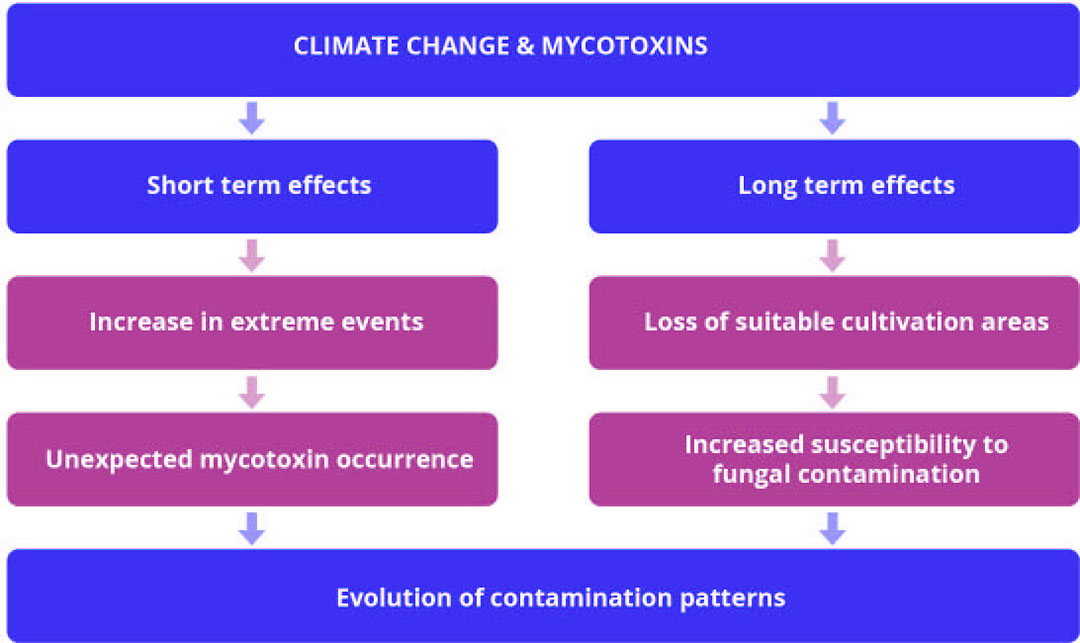Managing mycotoxins in times of climate change

Climate change is impacting grain harvests a little more every year, with unexpected mycotoxin contaminations that challenge our basic knowledge on mycotoxins. These evolutions stress the need for agility in mycotoxin risk management, to minimise the impact on animal health and performance.
Mycotoxin production stems from a tri-party interaction between the pathogen (mould), the host (plants) and the environment. Aspergillus, Penicillium and Fusarium are the main toxinogenic genera, but not all species and strains produce mycotoxins, and when they do, they can produce different ones. Plants have different sensitivities to moulds and mycotoxins. When it comes to feedstuffs, corn and its derivates (silage, DDGs, corn gluten meal) are the most at risk, while small grains like wheat and barley are at milder risk. Environmental conditions are the third stakeholder influencing mycotoxin production. Optimal conditions for mould growth (humidity, temperature) combined with any stressor such as parasites, abrupt weather changes or the presence of other moulds may lead to the production of mycotoxins. The combination of these different parameters determines the type and quantity of mycotoxins produced. Understanding these interactions and using mycotoxin occurrence databases allows to develop prediction tools and to assess occurrence patterns. Global occurrence patterns are well defined, with, for example, higher trichothecene (DON, T-2/HT-2 toxins) risk in the Northern hemisphere, and higher fumonisin and aflatoxin risk in Southern, hotter regions. Locally, climatic conditions, crop practices, plant varieties, etc. all are factors influencing mycotoxin risk, which thus can divert significantly from the global trends. Testing grains and feeds at the local scale is thus required to properly manage mycotoxin risk.
Figure 1 – Climate change influences mycotoxin contamination and compels to be agile in mycotoxin risk management.

Global climate changes
When it comes to global climate changes, they are the most important agro-ecosystem factor influencing the life cycle stages of fungi and their ability to colonise crops, survive, and produce toxins (Figure 1). A shift in their geographical distribution and in the pattern of mycotoxin occurrence is thus expected. In their review, Zingales et al. (2022) highlight the higher occurrence of Aspergillus flavus (aflatoxin producer) which outcompetes other moulds in hot conditions. Lately in South and Eastern Europe, years with hotter and drier weather than usual showed higher occurrence of A. flavus to the detriment of Fusarium spp. This correlates a higher incidence of aflatoxin contamination pre-harvest in this region, not considered at risk for aflatoxins in the past. Zingales et al. also report that due to the high-water activity Fusarium graminearum requires to develop and the wide range of temperatures it tolerates, its occurrence may increase in Central and Northern Europe, which is expected to be more humid until 2050.
Influence of weather patterns on mycotoxin risk
Weather patterns also influence the mould species that preferentially develop within a genus. During the 2022 season, the exceptionally hot and dry climate observed in Northwest France seemed to favour the development F.poae (nivalenol producer) against F. graminearum (DON producer) in corn crops. Besides, the high temperatures led to an early harvest that reduced mycotoxin development in the fall. As a result, nivalenol (NIV) was predominant against DON in corn silage, with median values of 455 ppb for NIV and 203 ppb for DON at harvest, while the average median levels in the previous years were respectively 300 ppb for NIV and 975 ppb for DON (Olmix Myco’Screen data). Such shift in the contamination pattern may lead to a misevaluation of the mycotoxin risk. While DON is tested as the sentinel mycotoxin in corn silage in this area, farmers could conclude to be at a low risk for mycotoxins while they had strong NIV contamination affecting their herd’s performance. The early detection of NIV risk helped farmers adjust their control plan and evaluate mycotoxin risk more adequately. When NIV was detected to be at risk, an adapted toxin binder was incorporated to the ration.
Figure 2 – 2022 mycotoxin risk for corn in the US Midwest.

Adapted mycotoxin analysis
Similarly in the US 2022 harvest, a higher poly contamination, yet with reduced DON occurrence was reported in the Midwest, while DON was always the major threat in this region (Figure 2, adapted from Neogen 2022 Mycotoxin Report). Indeed, there was no reported DON risk in Northern states but significant T2/HT2 toxins and Zearalenone (ZEA) contamination. In the South and Eastern Midwest, T-2/HT-2 toxins and ZEA were present as well, along with significant levels of DON and fumonisins (FUM). In this context, usual mycotoxin control plans could lead to an underestimation of the risk with important economic consequences for the producers. An adapted mycotoxin analysis combined with the use of a multi-mycotoxin binder when needed is key to preserve performance and profitability. In a local scientific trial, supplementing the diet of sows naturally exposed to mycotoxins with an algae-clay based mycotoxin binder significantly improved performance. The mycotoxin contamination was below the FDA recommendations, with an average level of 956 ppb of DON, 125 ppb of 15-o-acteyl-DON, 338 ppb of fumonisins and 62 ppb of zearalenone along the study. In this context, the algae-clay based decontaminant improved the body condition of sows entering in farrowing (+0.12 pt, P<0.05) and significantly improved farrowing performance. The number of piglets born alive increased by 4% (P< 0.01) and the proportion of mummies and stillborn was reduced by respectively, 39% and 34% (P< 0.05).
Accurate information = better decisions
Global warming is disrupting the basic knowledge on mycotoxin occurrence, with an impact on prediction tools. Climate change also has consequences on mycotoxin control plans, both on the global policies (monitoring of new mycotoxins, or in new areas), and for feed producers, pushed to have more exhaustive analyses of their feedstuffs. An adapted mycotoxin control plan is decisive to maintain profitability. The more accurate information on mycotoxin contamination, the better decisions can be made. Olmix assists in the development and adjustment of mycotoxin control plans of feed mills and provides decision aid tools and services to maintain optimal performance on farms.
Contact us to learn more about Olmix Myco’Tools and our complete range of toxin binders, adapted to each situation.
Join 13,000+ subscribers
Subscribe to our newsletter to stay updated about all the need-to-know content in the dairy sector, two times a week.






